Instructional Strategies and Engaging Pedagogies
2 Problem and Project Based Learning
Amena Karimi; Fatima Nasiry; and Zainab Mirzaie
Learning Objectives
After reading this chapter you will:
- Be able to differentiate between project-based and problem-based learning.
- Know effective strategies to improve students’ critical thinking and creativity skills.
- Develop projects that foster students’ independence, teamwork, and communication skills.
- Teach students how to organize, develop, and manage successful projects.
- Relate problem and project-based learning to the real world.
- Break down problems into components to process and provide solutions.
Abstract
This chapter contains an overview of the problem and project-based learning, its advantages, and challenges. The main focus of the chapter is on the effective tips and strategies for implementing this pedagogy in the k-12 setting. Moreover, it states how problem and project-based learning pedagogy is different from a traditional classroom while outlining its impacts on solving real-world problems and students’ life. This chapter is written based on reviewing several kinds of literature and their findings and also, real experiences of teachers from the internet and a podcast interview, which is included here as a source of information and knowledge sharing for instructors.
Introduction
Problem-based learning (PBL) is a student-centered approach where students learn about a subject or course by working in groups or individually to find the solution for an open-ended problem (Cornell, n.d.), and project-based learning (PBL) or project-based instruction is an instructional approach that gives students the opportunity to acquire knowledge and skills through interactive projects, along with the challenges and difficulties they may confront in the real world (M, K, 2022). Thus, problem- and project-based learning, when combined, is a learning method that allows students to enhance their understanding by experimenting with a project practically (Thomas, 2000). It requires them to design, execute, and assess projects that have real-world applications outside of the classroom (Westwood, 2008). According to Affandi et al. (2016), project-based learning and problem-based learning are terms that are employed in order to define a variety of instructional strategies. These approaches focus on students and provide them the opportunity to ask the teacher a question or several while working (Bell, 2010). The advantages of these approaches are to allow students to make decisions, find solutions to problems while learning, and develop their ability to think critically (Ndraka, 1985). PPBL has a wide range of applications in the student-centered method, in which students learn by experimenting and the teachers play a significant role in facilitating the instruction for the students.
This chapter discusses the problem and project-based learning, their differences, along with their advantages and disadvantages. In addition, the practical strategies to improve the student’s critical thinking and creativity skills include several ways the teachers use in their classes to enhance the student’s critical thinking and creativity skills. Furthermore, it includes tips on how to implement an effective PPBL that fosters student independence, develops student teamwork, and improves student communication and collaborative working skills. It also includes the key elements to consider for a successful project and ways to prepare the students to organize, develop, and manage projects. Moreover, this chapter covers the role of the problem- and project-based learning in solving real-world problems and the relationship between PPBL and traditional learning methods as well as how it is used in K–12 settings.
Problem-Based Learning
One educational strategy is problem-based learning, where students spend a lot of time researching and responding to solve challenges, and problems but authentic questions to gain Knowledge and skills (Hartman et al, 2013, p. 2). PBL is a targeted, practical form of education based on the evaluation, defense, and resolution of significant problems. students in this method learning practice many skills in a group to become skillful (Loyens et al, 2011 p.5). To facilitate student learning through the learning cycle, the instructor is a facilitator (Hartman et al, 2013, p. 2). Throughout the cycle, the students are presented with a problem scenario. By selecting the crucial information from the event, they construct and analyze the problem, representing the issue and developing theories regarding potential solutions.(Hussain et al, 2014 p.51). Finding knowledge gaps about the issue is a crucial step in this cycle, When students engage in self-directed learning, these knowledge gaps turn into what is known as learning difficulties (Loyens et al, 2011 p.4). Students then put their newly learned knowledge to use by applying it and evaluating their hypotheses in light of what they have discovered SDL. The teacher assists students in acquiring the cognitive skills required for cooperation in problem-solving. (Silver, 2004, p.237).
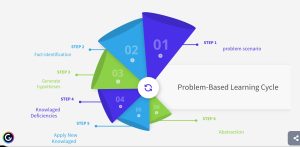
Figure 1 The process of problem-based learning
Problem-based curricula give students supervised opportunities to learn by resolving challenging real-world issues. according to Silver (2004), PBL was created with several significant goals which are listed below.
- It is intended to support students in building a broad and flexible knowledge base,
- Effective problem-solving abilities,
- Self-directed,
- Lifelong learning skills,
- Effective collaboration abilities, and intrinsic motivation to learn.
Project-Based Learning
PBL is a teaching method based on practical assignments that pose challenges for students to solve as well as learning activities. Also, PBL is described as a student-driven (student-centered) approach to learning in which students are obliged to engage in a real project by formulating a topic or inquiry and working under the guidance of teachers to produce a project to present to a select audience (Le, 2018 p.2). In other words, students are involved in creating their research questions, organizing their research, planning their learning, putting into practice a variety of learning methodologies, and evaluating their projects that have applications outside of the classroom. These tasks allow students to work largely independently for lengthy periods and result in realistic presentations or products (Colley, 2008, p.27).
The same to problem-based learning, project-based learning works through a cycle. This cycle includes Orientation, a project’s identification, Planning, implementing a project, reporting project findings, and evaluation. Students will be familiar with the project’s question, significance, methodology, resources, and timetable by the end of this cycle. Then they define each member’s function and accountability. Finally, they need to assess their workflow (Colley, 2008, p.27).
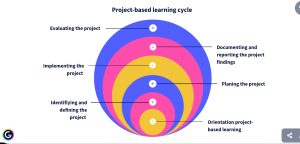
Figure 2 The Process of Project-Based Learning
After suffering for a while in most academic contexts, many students discover the purpose and justification for learning by working on projects. Project-based learning can assist students in meeting state requirements and preparing for state exams by aiding the acquisition of subject-matter knowledge as well as reasoning and problem-solving skills. It shows that PBL’s ability to engage students and motivate those results in high achievement. A larger variety of learning opportunities can be introduced into the classroom through PBL. According to Le (2018), PBL in teaching and learning provided these significant goals which are listed below.
- Students’ academic achievement
- Students’ understanding of the subject matter
- Students gain an understanding of related skills and strategies
- Students’ positive attitudes toward learning
- Perceived changes in work habits and other PBL process behavior
What Is the difference between Problem and project-based learning
Problem-based learning and project-based learning are frequently mixed. This may be partially because the abbreviation PBL is commonly used to describe both techniques. Although they are similar, problem-based learning and project-based learning differ in a few significant ways. Students participate in both PBLs by striving to provide answers to or resolve issues. In both approaches, students are tasked with coming up with a unique solution to challenging problems that lack an obvious solution. The result that students produced is the primary distinction between problem- and project-based learning. In a problem-based learning class, students just emerge a solution to a problem. While Students in project-based learning must develop their concepts and finish a comprehensive project (Lynch, 2017). One type of problem-based learning is project-based learning (PBL), which differs from other kinds of PrBL encounters in a few key ways. Both PBL and PrBL begin with a real-world problem, but the two have slightly different processes and results (Segar, 2021).
Video 1 Difference between problem and project-based learning
Advantages and Disadvantages of Problem and Project-Based Learning
According to Jones (2006) and Mihic and Zavrski (2017), problem and project-based learning have several advantages in the learning process, while it has some challenges either, some of which are listed below.
Advantages
- Avoiding overload of information and focusing on learning fundamental information that is applicable to real-world circumstances.
- Fostering the development of significant transferrable skills that are beneficial for lifetime learning. They include team leadership, communication, and problem-solving.
- Allows control over and opposition to the learning process. encouraging pupils to be responsible for their own learning. This is a key skill for medical specialists who actively participate in their own ongoing professional progress throughout their careers.
- Strengthens analytical reasoning. Learners are more motivated to learn when learning is centered on “real-life” occurrences.
- Improves problem-solving and higher-order cognitive abilities. It promotes a deep rather than a surface-level approach to learning by requiring students to interact with the content in greater depth and on more levels than in typical teaching approaches.
Disadvantages
- Because the facilitator job has taken the place of the traditional teaching role, it could be difficult for trainees to emulate effective teachers as role models.
- Teaching staff members should foster learning rather than quickly transfer their knowledge. To academics, this could be perceived as unproductive and even demotivating.
- Why Information acquired through PBL is less structured than information acquired through traditional learning.
- Training facilitators can be difficult, and there aren’t many academics that have facilitating abilities in addition to more traditional teaching ones.
- The time commitment that trainees must make to PBL. For aspiring anesthetists or prospective doctors of acute care, this can be particularly challenging.
- Time limitations on the creation, administration, and administration of PBL courses.
Effective Strategies to Improve the Student’s Critical thinking and Creativity skills
Problem-and project-based learning is an essential pedagogy for developing creative thinkers and learners. Students answer genuine problems by creating their own queries, making plans for their own learning, arranging their research, and putting a variety of learning techniques into action. Students thrive in this student-centered, motivating learning environment and develop valuable skills that will lay a reliable foundation for their success.
Critical Thinking
The skill to interpret data, draw assumptions, demonstrate points effectively, analyze data, and assess data is referred to as critical thinking. However, the student’s critical thinking skills are still developing (Anazifa et al., 2017). Critical thinking, which also refers to higher-level thinking (higher-ordered thinking or higher-level thinking), consists of the top three competencies in Bloom’s Taxonomy: the capability to analyze, summarize, and assess (Bookhart, 2010; Moore & Stanley, 2010). Critical thinking skills can be developed through open-ended or distinct questions. Anazifa et al. (2017) cite that open-ended questions are those that have multiple right answers. Hence, problem-based learning is among the learning methods that promote critical thinking skills, particularly in science. Problem-based learning introduces problems that motivate students to consider not only the reason but also the method for addressing the issue (Strobel & Barnevel, 2009). Students’ abilities to think critically can be developed and improved through problem-and project-based learning.
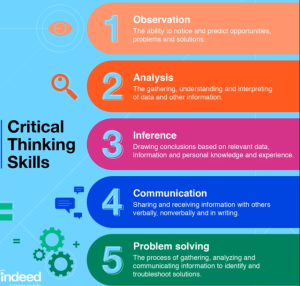
Figure 3 Critical Thinking Skills
Creativity Skills
The goal of creativity development is to train students to confront challenges while working in groups or individually (Kind & Kind, 2007). According to Trilling and Fadel (2009), creativity can be discovered in an environment that promotes queries, persistence, willingness to explore innovative ideas, high trust, and acquiring knowledge from failures and mistakes. Continual practice can assist in increasing the student’s creativity. For example, learning through projects to solve real-world problems is among the most effective methods for fostering creativity. In addition, Anazifa et al. (2017) cite that creative thinking has a significant impact on students’ academic achievement along with PPBL.
How to Improve Critical Thinking and Creativity Skills?
There are several ways for improving critical thinking creativity and abilities, Jamie Birt. (2019):
- Increase Self-Awareness: The student should think about their thought processes, values, morals, integrity, and other perceptions as their self-awareness grows. The teachers should teach them to consider their preferences and dislikes with objectivity. The teachers can better understand their students’ perspectives by becoming more aware of their personal preferences, areas of strength, and prejudices.
- Recognize the Student’s Cognitive State: The way students obtain and apply relevant data should be determined and analyzed. It is crucial to understand a person’s listening, perceiving, and responding processes in order to improve cognitive productivity in group or individual work. Being a critical thinker involves being aware of our prejudices and how they impact our decisions and choices. The students must take some time to consider their thought processes before attempting to make a decision. They will be able to react more logically as a result.
- Develop Vision: Students should be taught to consider how others might respond to a circumstance or decision they make. It’s important to consider a condition’s possible consequences as well as any factors that could have a positive or negative impact on it. Making the best choice will be facilitated by having the foresight to foresee the reactions that their behavior in collaborative work will result in.
- Practice Active Listening: Critical thinking requires active listening as a fundamental skill. While collaborating with their peers and being guided by their teachers, students must be attentive and listen intently. They should practice empathy and concentrate on comprehending the viewpoint of their adversary. Understanding what they want, need, or anticipate in great detail can help them respond positively and produce positive results.
- Ask Questions: Students must always ask their teachers for explanations if they have questions. They could, for instance, ask about the things they already know to make sure that everything they already know is accurate, or they could ask follow-up questions to find out if there was any specific information that was overlooked or misunderstood. This step can help students give information a purpose and value.
- Examine the Available Evidence: The students must practice critical thinking to reach their final decision, which they must support with evidence from their past experiences. By conducting experiments, organizing facts, and using prior experience as available evidence, students can come up with a more appropriate and effective method for working within the present.
In addition, Jamie Birt (2019) states that taking part in team-building exercises, looking for leadership positions, and seeking assistance from an instructor can all help students develop their critical and creative thinking abilities.
How do Problem and Project-Based Learning foster students’ independence?
Independence or self-directed learning is the learning that students learn by doing on their own. It does not mean students take isolated from others but students for learning communicate and take guidance from others. In self-directed learning, the teacher is not the one who teaches each and single part of the subject, but students independently go to search and learn (Kapur, 2019 p.1). The importance of self-learning leadership is that the student is not limited to the teacher’s method, theory, and plan, but seeks different and new ways to learn and complete her or his project (Tripon, 2015 p.40). This makes the student learn and gain experience beyond what is expected (Kapur, 2019). These project-based learning techniques enable students to engage in self-directed learning (Bagheri et al. 2013 p.19):
- The organization of learning around real-world problems
- Student-centered instruction
- Collaboration
- Teacher as facilitator
- Authenticity through the use of authentic materials and audiences
- Formative assessment
- Reflection
- And the production of authentic artifacts
Teamwork Development in Problem and Project-Based Learning
Teamwork is small group students accomplishing unit goals work together on one project. Teamwork has several advantages it encourages students to learn from one another, students get social support for individual efforts, and students through teamwork learn different skills (Campbell & Siha, 20015 p.2). A successful team has these characteristics, it helps the member learn from diverse knowledge, skills, experiences, and interests of team members; the team helps members find creative responses to challenges; the team accelerates the product, services, and profitable strategies and the team directed the challenges to a productive direction (Serrat, 2017 p4). In today’s world, most organizations in different parts accept teamwork because they think the team is more helpful for solving problems than the individual. Mainly the problem with these features (Serrat, 2017 p2.3):
- The problem is relatively complex, uncertain, and holds the potential for conflict
- The problem requires inter-group cooperation and coordination.
- The problem and its solution have important organizational consequences.
- Deadlines are tight but not immediate.
- Widespread acceptance and commitment are critical to successfully implementing a response to a situation, condition, or issue.
In PPL, the teacher typically assigns a group project that the students must complete by the end of the term. Working on projects helps students develop a variety of abilities, including active listening, communication, problem-solving, team building, task allocation, and team relationships, also learning delegation, quality standards, and goal-setting techniques (McCuddy et all, 2002 p.7).
Improving Students’ Communication Skills via Problem and Project-Based Learning
A meaningful exchange of thoughts, opinions, ideas, viewpoints, or messages between at least two people is often regarded as communication or it may also be seen as an exchange of concepts and knowledge to create a shared understanding for the efficient operation of business associations. (S U Putri and S Hidayat, 2019 p. 2). Good communication has these qualities: First, it is clarity. Good communication must transform the messages clearly without any wrong pronunciation, grammar matters, and wrong spelling words. Also, the information must be unity and coherent. It helps there not be any doubt or misunderstanding for the receiver. Second, good communication is brevity, we should communicate with few words. It means in a short time try to transform your message into simple and short words instead of long phrases. Conciseness, avoid misunderstanding and confusion among receivers. Third, communication should be complete. It should include facts and necessary information. Communication shows the personality and images of a person and organization. Incomplete information is the waste of time and shows the weakness of the sender. Additionally, in good communication sender considers the feeling and wishes of the receivers. Finally, listening with patience is one of the most important characteristics of communication related to the receiver. The receiver should pay attention with patience does not harry to respond especially in oral communication (Girdhar & Malik, 2018 p1.2). Problem-based project-based learning encourages students to practice their communication skills throughout each term of their academic careers, it means Students can connect and communicate with one another while working on a project by engaging in activities, and as they complete the project, they use their persuasive skills to share ideas and persuade one another(S U Putri and S Hidayat, 2019 p. 8). By the way, Students will learn how to communicate effectively by practicing how clarity, conciseness, completeness, and consideration communicate.
Elements to Consider for Successful Projects
Problem and project-based learning enable the students to work collaboratively with their classmates to share their team working skills and design a successful project. Realistic projects typically require success criteria. However, PBL requires students to tackle real-world issues (Bell, 2010).
According to Wyman. (2020), the elements to be considered for making a Project successful are;
- Provide meaningful real-world connections: The students need to be given real-life problems to be able to comprehend them thoroughly. Developing a component in real life instills importance while also stimulating curiosity, awareness, and emotional development.
- Make time for practical learning: Students are required to make time for experiential learning elements that require them to examine and experience them through trial and error. Knowledge gained from failed attempts is equally beneficial for implementation as knowledge gained from successful attempts.
- Provide opportunities for team building: Allow students to collaborate creatively so that they can express their views and test ideas to increase participation and class connection. Instead of relying solely on the teacher, students can benefit from one another and gain confidence as researchers and observers.
- Reconsider the driving question: It is critical to stay focused on the question in order to solve the problem and complete the project-based learning project successfully. Sticking to the driving question makes sure that the definition of the component is not lost, that your rubric accurately examines your key goals, and that students are aware of its greater emphasis and benefit.
- Differentiate through teams: Educators must divide the students wisely to verify the type of success the teacher knows they require. Make a distinction based on academic excellence, communication ability, personal preferences, or motivating factors. This provides students with better opportunities of grasping the material in the ways that are most effective for them. This, in turn, helps them feel personally and academically successful within the group.
- Focus on student-driven learning: Once the problem and project-based learning projects are underway, remember that students will need this time to research and discover new thoughts by the teacher’s guidelines.
- Include self-assessment: Accountability and in-depth interpretation are encouraged when students are asked to evaluate their work and performance as valuable teammates, leaders, observers, and collaborators. If these assessments have been a regular practice, students frequently begin to recognize how they have enhanced their interpersonal skills.
- Reflect on your progress: These reflections help teachers improve each element of project-based learning so that it gets better with every iteration and the students get the most out of it.
Ways to Prepare the Students to Organize, Develop, and Manage Projects
Project organization, development, and management have emerged as essential skills for learners who have started organizing their work in the form of projects led by groups of students with the goal of achieving successful objectives for their project (Kloppenborg. et.al, 2016). Furthermore, Kloppenborg et al. (2016) cite that to meet project criteria and deal with various challenges while working on a project, project management necessitates applying skills, tools, and methods for executing the project. (PMI, 2000, p. 6)
The following are some ways that problem and project-based learning can help students prepare. (Method Schools Team, 2017):
- Time management: A successful project needs an incredible quantity of time management to be developed and presented in order to be organized, developed, and managed. To accomplish a project by a specific deadline, the student should first ascertain how much time they will need to allocate as a whole. They must then divide a certain time period into relatively small, more achievable steps. Students would be more ready to work on complex projects if they had the chance to acquire this expertise through a wide range of projects.
- Organizational skills: Assembling projects teach students the value of organization, both physically and mentally. This is certainly relevant if they are provided with a separate working environment, which they must maintain organized. It also relates to individuals who collaborate in communal environments like group work and are responsible for organizing their own opinions, concepts, and materials.
- Collaboration Skills: The students should be taught how to work collaboratively while working with their peers, which will enable them to enhance their skills by working as part of a group. In addition, it allows the students to look at the importance of teamwork thoroughly, which is an indispensable learning opportunity when it comes to working in a cooperative environment as part of a group.
- Problem-Solving Skills: Traditional methods of instruction necessitate students to learn in an extremely passive way. For instance, passive learning in the traditional school setting involves students listening to long, unsatisfying lectures. However, problem- and project-based learning encourages learners to think outside their comfort zones and find solutions in a new and exciting manner.
- Self-Direction: The ability to divide any activity into achievable pieces in order to determine what to do next is a critical skill that every education system should assist students in developing. It is even more significant to have the motivation to complete those activities. These two abilities combine to produce a person with wonderful work. Thus, problem and project-based learning expand the student’s knowledge to organize, develop, and manage a project with productive results.
- Ability to Find Information: To organize, develop, and manage important tasks, the creator must conduct extensive research. Because lecture-based and memorization-based learning are rarely used in project-based learning, students must conduct their own research. This is a critical step in the procedure because it teaches students how to find helpful information.
- Constant state of Learning: The most incredible positive aspect of problem and project-based learning is the enthusiasm it fosters in students. Students in a project-based learning classroom enhance a long-standing willingness to satisfy their curiosity since the projects designated almost exclusively focus on subjects that intrigue them and also play an influential role in their education. This seems to be best suited for acquiring new abilities and adapting to environments that change frequently. Project-based learning is an excellent alternative to traditional curricula, particularly for preparing students for upcoming group projects for their further education.
Bell (2010) states students complete a self-evaluation at the end of the project. They assess not only their own learning but also the effectiveness of their interpersonal relationships. They consider their communication skills and whether they could communicate with other students in terms of listening thoroughly to their ideas and having their own perspectives heard. Effective implementation and practice of this expertise will contribute to competency and deep understanding over time.
Role of Problem and Project-Based Learning in Solving Real-World Problems
Problem-based learning is about solving real-world problems in unique ways. In problem and project-based learning, students are immersed in real-world issues, helping them to develop critical thinking, metacognitive abilities, creativity, and invention (Devilee, 2008). One of the important characteristics of PPBL is that it uses real-world, relevant problems that are meaningful to learners and makes learning more personalized and practical.
Where did Problem-Based Learning Emerge from?
Problem-based learning was first implemented at McMaster University of Canada in the 1970s (Barrows, 1994; Norman and Schmidt, 1992 as cited in Gallagher, 1997). The McMaster team of the medical school noticed that there are big differences between medical students whose time was passed with textbooks and physicians in their examining room. They discovered that, although medical students had only the correct answers and were not flexible thinkers, physicians were constantly willing to modify their thoughts and build new notions of what was wrong with patients. The McMaster university team came up with the next best thing—simulated patients, who are frequently taken from genuine case files—after seeing that learning environments where students were engaged with textbooks but not real case patients maintained the students as constrained learners. Assigning relevant texts and educating pupils on problems are preferable. By using teachers as problem-solving guides rather than as all-knowing experts, PBL transformed traditional learning into problem-based learning (Gallagher, 1997). It later spread to other disciplines of economy, business, law, and education. Because PBL has a strong emphasis on real-world issues and social processes, it belongs to the social family of educational practices.
Problem and Project-Based Learning Vs Traditional Learning
The concept of one-size-fits-all instruction is associated with traditional education. This type of training makes the assumption that regardless of their innate talents and abilities, all students must go through their education at the same rate and with the same resources in order to reach the same level of abilities, knowledge, and skills. This helps them design unique assessments that raise the bar for all students to the same level. But students are really different from one another. Each of them possesses a distinctive skill, learning style, IQ, and rate of information processing (Samurai, 2021). Whereas John Dewey’s concept of subject matters in learners was the foundation for problem and project-based learning in his book Education and Democracy. He believes that “knowledge exists as the content of intelligent ability—the power to do” (p.192). The qualities that individuals learn by doing—such as how to walk, talk, read, write, skate, ride a bicycle, operate a machine, calculate, drive a horse, sell goods, manage people, and so forth—stick with them the longest (Dewey, 2001). The following table makes the differences between the 2 models and their learning outcomes easier to understand.
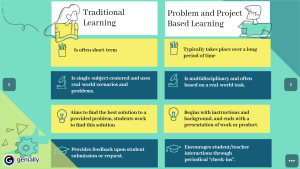
Figure 4 PPBL vs traditional learning Method
Problem and Project Based learning in the k-12 setting
PBL appears to be a successful method for raising students’ accomplishment levels and is a potent tool for tying students to their community with actual goals and audiences. It is crucial that kids understand they have a voice and what can potentially lead to change. There is a link between the students’ project’s purpose and every class. Therefore, PBL through civic education is a crucial component of students becoming engaged, contributing, and functioning citizens of their communities (Edutopia, 2017). Because they meet problems without conducting any background research and with knowledge insufficient to address the challenge, PBL calls for students to expand their existing knowledge and understanding and apply this expanded understanding to propose a solution. “Ill-structured” problems without a single, straightforward, or formulaic answer inspire students to ask questions and look for more information (Wirkala and Kuhn, 2011).
Significant Effects of Problem and Project-based learning on students’ personal and academic lives
- Critical Thinking and Problem-Solving Skills
To fulfill the criteria of the 21st century, one of the eligibility requirements is the ability to think critically and solve problems. When searching for accurate solutions and understandings about the real world, critical thinking refers to a trustworthy and effective mental process. It mostly concerns the process of evaluating concepts in a more concentrated manner (Sholihah and Lastariwati, 2020). One of the instructional approaches that promote critical thinking and problem-solving abilities is problem and project-based learning. In this model, the amount of knowledge transferred from teacher to students is not as important as the development of critical thinking competence. By utilizing their communication, problem-solving, critical thinking, and independent learning skills, it allows students the freedom to tackle educational challenges. This ability to solve problems can be observed in how students look into a situation and identify solutions (Ernawat, 2022). Through PPBL, students will learn the process of solving problems through the following steps which are a part of design thinking too.
- Determine the problem.
- Make a list of all potential solutions or actions.
- Consider all of the options.
- Decide which approach to try.
- Use the answer to your problem.
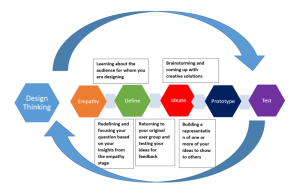 Figure 5 The design thinking process of problem-solving
Figure 5 The design thinking process of problem-solving
The process of students working to solve a real-world problem is an illustration of design thinking in which children use real-world situations to address problems and come up with solutions (Wikibooks, 2016). Understanding the problem at hand is a crucial indication of the problem-solving abilities that need to be developed during learning. This is consistent with the beginning steps of the PBL paradigm, which entail posing problems for students to solve. Students are taught to comprehend a problem, formulate a solution, implement the solution as planned, and evaluate all phases through problem-based learning (Sari et al., 2020).
- Collaborative Activities
Research has demonstrated that using a team to work on projects to find answers or ideas for problems in the real world increases students’ social attitudes toward teamwork. A problem and project-based learning approach involves students in team and collaborative activities. In a capstone college course, around 85% of students reported receiving good feedback regarding their team’s performance, according to a research by Kapp (2009). This course was evaluated in 2 steps of individual and collaborative assessments to show how students develop through peer reviews and feedback. Adopting PPBL from elementary to higher education creates the social attitude of teamwork for students. Not only the educational life but personal and academic life of students requires the skill of collaborative working. According to AC Nielsen Research Services (2000) as cited in (Jalinus et al., 2020) employers are looking for people with abilities including creativity, problem-solving, and cooperation. According to Wulandari et al. (2015), in the workplace, problem-solving requires strong teamwork in addition to knowledge and abilities. According to the study by Setiawan and Soenarto (2017), three competencies—teamwork skills, self-management skills, and technological skills—have a high level of needs when it comes to categorizing the effective competency of graduates required by the sector. Students can encourage one another and aid in the success of their projects by working on cooperative projects. Many students encounter both technical and non-technical issues when completing projects, and teamwork is the key to resolving these issues. Since they are aware of it, students naturally develop their collaborative skills to address difficulties (Jalinus et al., 2020).
Conclusion
Students explore to learn about a subject via problem- and project-based learning, which is a student-centered educational strategy.(Thomas, 2000). Most people think problem-based learning and project-based learning look similar, but there are a few significant ways they differ. While in a project-based learning session, students are required to develop their ideas further and complete a whole project, students in a problem-based learning lesson are only required to come up with a solution to an issue. (Lynch, 2017). Although there are some challenges to the implementation of PPBL like a lack of professional facilitators, a lack of time, and less structured information, the implementation of this method of learning has effective outcomes. First of all, PPBL fosters the students’ independence. In this method, it is not the teacher’s responsibility to provide or teach everything to the students; they learn every single thing through working on a project, and the teacher is a facilitator. Second, project-based learning fosters the development of delegation, quality standards, and goal-setting abilities in students. These skills include active listening, communication, problem-solving, team development, task allocation, and team relationships.(Method Schools Team, 2017). Third, engaging in project-related activities encourages student interaction and communication. As they work on the project, they make every effort to share ideas and convince one another(S U Putri and S Hidayat, 2019).Students will practice effective communication skills like clarity, brevity, conciseness, completeness, and consideration through the projects (Girdhar & Malik, 2018 p1.2). Finally, the PPBL develops the critical thinking and creativity skills of the students. Students in PPBL practice the process of solving problems critically by identifying the problem, finding a list of possible solutions, considering the possible solutions, attempting the chosen solution, implementing the solution, and assessing the solution (Colley, 2008, p.27). In addition, there are plenty of methods to advance critical thinking and creativity skills, such as increasing self-awareness, recognizing students’ cognitive states, developing vision, practicing active learning, asking questions, and examining the available evidence. Furthermore, problem- and project-based learning allows the students to perform the given tasks collaboratively with their classmates to share their teamwork skills and design a successful project. The key elements to be considered for a successful project are providing meaningful real-world connections, making time for practical learning, providing opportunities for team building, Reconsidering the driving question, differentiating through teams, focusing on student-driven learning, including self-assessment, and reflecting on the student’s progress. Implementing this model in traditional classrooms is possible. Hence, it develops students’ skills in solving real-world problems. Students will acquire enough knowledge and skills in school to prepare them for future real-world challenges.
Review Questions
We will consider the two strategies of generative learning.
- Teaching others – the readers will be able to comprehend this chapter’s context.
- Drawing- A visual graphic organizer from the concept of problem and project-based learning can help readers to imagine and get the practical method of applying the method for students.
Recommended Readings
Jalinus, N., Syahril, S., Nabawi, R. A., & Arbi, Y. (2020). How project-based learning and direct teaching models affect teamwork and welding skills among students. International Journal of Innovation, Creativity and Change., 11(11), 85-111.
Stephanie Bell (2010). Project-Based Learning for the 21st Century: Skills for the Future, The Clearing House: A Journal of Educational Strategies, Issues and Ideas, 8:2, 39-43, DOI: 10.1080/00098650903505415
Silver. C.E.H. (2004). Problem-based learning: what and how do students learn. Journal e?education Psychology Review, Vol. 13, No.3, https://www.brown.edu/academics/medical/sites/brown.edu.academics.medical/files/uploads/Hmelo-Silver,%20Problem-Based%20Learning%20What%20and%20How%20Do%20Students%20Learn_0.pdf
Receive a badge
After reading our badge you may receive a badge clinking below button:
Key Terms
- Project-based Learning: The emphasis of project-based learning is on developing an interactive environment for learning in the classroom where students can actively explore problems and challenges from the real world and gain a deeper understanding.
- Problem-based Learning: Problem-based learning is a student-centered technique where students will gain knowledge about a subject or course by working through an open-ended problem discovered in the material.
- Project Management: Project management is the process of controlling a group’s activity to fulfill the project’s purposes within the time given.
- Critical Thinking: A fundamental component of critical thinking is a questioning and challenging attitude toward information and received wisdom. It entails considering concepts and facts objectively in light of our objective standpoint in light of our values, attitudes, and personal philosophies.
- Creativity Skills: It is the ability to generate something in a new form and it includes assessment, open-mindedness, problem-solving, organization, and communication.
- Bloom’s Taxonomy: This is a hierarchical classification of thinking levels that should be used when developing course objectives.
Podcast Episode
In the podcast episode, we have introduced our topic and its importance. Also interviewed an education expert, Sayed Mohammad Nazim Uddin; an Associate professor at Asian University for Women who shares his experience about the problem and project-based learning in his teaching experience, its effects, challenges, and effective strategies for implementation of the problem and project-based learning for educators.
Part 1
Part 2
Part 3
References
Affandi, Ahmad & Sukyadi, Didi. (2016). Project-Based Learning and Problem-Based Learning for EFL Students’ Writing Achievement at the Tertiary Level. 10.14456/rjes.2016.2.
Alison Doyle. (2022). What is creative thinking? The Balance. https://www.thebalancemoney.com/creative-thinking-definition-with-examples-20637440
Anazifa, Rizqa & Djukri,. (2017). Project- Based Learning and Problem-Based Learning: Are They Effective to Improve Student’s Thinking Skills?. Jurnal Pendidikan IPA Indonesia. 6. 346-355. 10.15294/jpii.v6i2.11100.
Bagheri.M, Ali.W. Z. W, Abdullah. M. C. B, Daud. S. M. (2013). Effects of Project-based learning strategy on Self-directed Learning skills of Education Technology students. Research Gate, DOI:10.30935/Medtech/6089.
Bloom’s Taxonomy. (n.d.). WHAT IS BLOOM’S TAXONOMY? Resource for Educators. https://bloomstaxonomy.net/
Brookhart, S. M. (2010). How to Assess Higher-Order Thinking Skills in Your Classroom. Alexandria:ASCD.
Campbell. S.M. Siha.S. (20015). Teamwork. ResearchGate https://www.westga.edu/~bquest/2015/teamwork2015.pdf
Cognition and instruction/Problem-solving, critical thinking and argumentation – Wikibooks, open books for an open world. (2016). Wikibooks. https://en.wikibooks.org/wiki/Cognition_and_Instruction/Problem_Solving,_Critical_Thinking_and_Argumentation/
Collelete, A.T., & Chiappeta, E.L. (1994). Science Instruction in The Middle and Secondary School. New York: Macmillan Publishing Company
Colley. K. (2008). Project–based science instruction: A primer an introduction and learning cycle for implementing project-based science. Sci Teach 75 no8. http://impact.utoledo.edu/docs/PBS%20Instruction%20A%20Primer.pdf
Cornell University. (n.d.). Problem-based learning. Welcome | Center for Teaching Innovation. https://teaching.cornell.edu/teaching-resources/engaging-students/problem-based-learning
Devilee, A. (2022, April 12). What is problem based learning? | Instructional design. Instructional Design Australia. https://instructionaldesign.com.au/problem-based-learning/
Dewey, J. (1966). Democracy and education (1916). Jo Ann Boydston (ed.). The Middle Works of John Dewey, 9, 1899-1924.
Edutopia. (2017, June 20). Project-Based Learning: Raising Student Achievement for All Learners [Video]. YouTube. https://www.youtube.com/watch?v=eGWqBZSFgxE
Ernawati, M. D. W., Rusdi, M., Asrial, A., Muhaimin, M., Wulandari, M., & Maryani, S. (2022). Analysis of Problem Based Learning in the Scaffolding Design: Students’ Creative-Thinking Skills. Cypriot Journal of Educational Sciences, 17(7), 2333-2348.
Gallagher, S. A. (1997). Problem-based learning: Where did it come from, what does it do, and where is it going? Journal for the Education of the Gifted, 20(4), 332-362.
Girdhar. A. P, MaliK. A. K (2018). The essence of effective communication. Research Gate, https://www.researchgate.net/publication/326534323_Essence_of_Effective_Communication/citations
Hartman. B. K, Moberg. C.R., Lambert. J.M. (2013). Effectiveness of problem-based learning in the introductory business courses. Journal of Instructional Pedagogies. https://files.eric.ed.gov/fulltext/EJ1097131.pdf
Hidayat. S, Putri. S. U. (2019). The effectiveness of project-based learning on students’ communication skills in science. Journal of Physics Conference Series. DOI: 10.1088/1742-6596/1318/1/012006. https://journals.sagepub.com/doi/epdf/10.1177/1052562904266008
Hussian. O ,Mohad.B, Suliaman.A.(2014). An Innovative Learning Cycle in Problem-Based Learning. International Journal of Enhanced Research in Educational Development (IJERED), Vol. 2. www.erpublications.com
Jalinus, N., Syahril, S., Nabawi, R. A., & Arbi, Y. (2020). How project-based learning and direct teaching models affect teamwork and welding skills among students. International Journal of Innovation, Creativity and Change., 11(11), 85-111.
Jamie Birt. (2019). How to improve critical thinking skills at work in 6 steps. Indeed Career Guide. https://www.indeed.com/career-advice/career-development/how-to-improve-critical-thinking
Jones, R. W. (2006). Problem-based learning: description, advantages, disadvantages, scenarios and facilitation. Anaesthesia and intensive care, 34(4), 485-488.
Kapp, E. (2009). Improving student teamwork in a collaborative project-based course. College Teaching, 57(3), 139-143.
Kapur. R. (2019). Significance of Self-Directed Learning. Research gate, https://www.researchgate.net/publication/335096519_Significance_of_Self-Directed_Learning
Kind, P. M., & Kind, V. (2007). Creativity in Science Education: Perspectives and Challenges for Developing School Science.
Kloppenborg, T. J., & Baucus, M. S. (2016). Project Management in Local Nonprofit Organizations: Engaging Students in Problem-Based Learning. Journal of Management Education. https://doi.org/10.1177/1052562904266008
Le. T.T.K. (2018). Project based learning in 21st century: A review of dimensions for implementation in university-level teaching and learning. 4th ICEAC International Conference on English across Cultures. https://www.researchgate.net/publication/352977987_Project-based_Learning_in_21st_Century_A_Review_of_Dimensions_for_Implementation_in_University-level_Teaching_and_Learning
Loyens.M.M.S , Kirschner.P.K, Paas.F. (2011). Problem-based learning. Institutional repository for the University of Wollongong.Vol.3, https://ro.uow.edu.au/edupapers.
Lynch, M. (2020, May 9). What is the difference between problem, project, and challenge based learning? The Edvocate. https://www.theedadvocate.org/difference-problem-project-challenge-based-learning/
M, K. (2022). Project-based learning: Benefits, examples, and resources. PowerSchool. https://www.powerschool.com/blog/project-based-learning-benefits-examples-and-resources/
McCuddy. M. K, Christ. M. Y, Pirie. W.L, (2002). Teams in the classroom: Beyond the Group Project. Research Gate, DOI: 10.1007/978-94-017-1392-4_8.
Method Schools Team. (2017, March 8). 7 ways project-based learning prepares students for the future. SoCal’s Leading Online K-12 Charter School. https://www.methodschools.org/blog/7-ways-project-based-learning-prepares-students-for-the-future
Mihic, M., & Zavrski, I. (2017). Professors’ and students’ perception of the advantages and disadvantages of project based learning. Int. J. Eng. Educ, 33(6), 1737-1750.
Moore, B., & Stanley, S. (2010). Critical Thinking and Formative Assessment: Increasing The Rigor in Your Classroom. Larchmont: Eye on Education Inc Yogyakarta: UNY Press
Ndraka, T. (1985). Teori metodologi administrasi. Jakarta: Bina Aksara.
Samurai, S. (2021, September 24). Project-based learning vs traditional learning: Which is better?. Kids coding, Robotics & STEM classes in Sydney. https://skillsamurai.com.au/blog/project-based-learning-vs-traditional-learning-which-is-better
Sari, Y. I., Utomo, D. H., & Astina, I. K. (2021). The Effect of Problem Based Learning on Problem Solving and Scientific Writing Skills. International Journal of Instruction, 14(2), 11-26.
Silver, H.C.E. (2004) Problem-Based Learning: What and How Do Students Learn? Educational Psychology Review, 16, 235-266.
http://dx.doi.org/10.1023/B:EDPR.0000034022.16470.f3
Segar, S. (2021, January 5). Project-based learning vs. problem-based learning. SpacesEDU. https://spacesedu.com/en/project-based-learning-vs-problem-based-learning/
Stephanie Bell (2010) Project-Based Learning for the 21st Century: Skills for the Future, The Clearing House: A Journal of Educational Strategies, Issues and Ideas, 83:2, 39-43, DOI: 10.1080/00098650903505415
Strobel, J., & Van Barneveld, A. (2009). When Is PBL More Effective? a Meta-Synthesis of MetaAnalyses Comparing PBL to Conventional Classrooms. Interdisciplinary Journal of Problem-based Learning, 3(1), 4.
Thomas, J. W. (2000). A Review of Research on Project-based Learning. Report prepared for The Autodesk Foundation. (online). http://www.bie.org/index.php/site/RE/pbl_research/29.
Tripon.C. (2015). Importance of Self-Directed Learning. Logos Universality Mentality Education Novelty, Section:Social Sciences, 2015, IV (1), http://dx.doi.org/10.18662/lumenss.2015.0401.03.
Westwood, P. (2008). What Teachers Need to Know about Teaching Methods. Camberwell, Victoria: Acer Press.
Wirkala, C., & Kuhn, D. (2011). Problem-based learning in K–12 education: Is it effective and how does it achieve its effects?. American Educational Research Journal, 48(5), 1157-1186.
Wyman. (2020, March 4). 8 ways to ensure success of project-based learning units | Resilient educator. ResilientEducator.com. https://resilienteducator.com/classroom-resources/project-based-learning-tips




